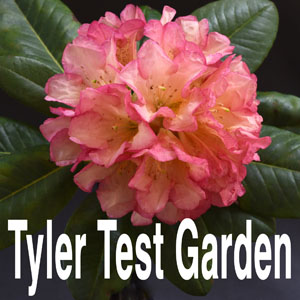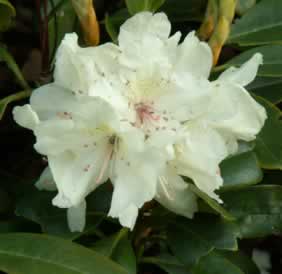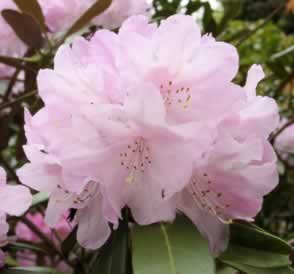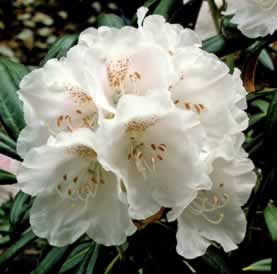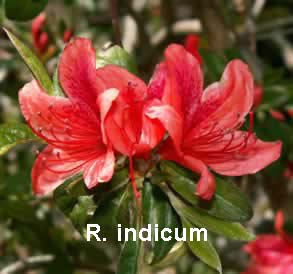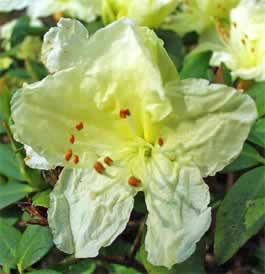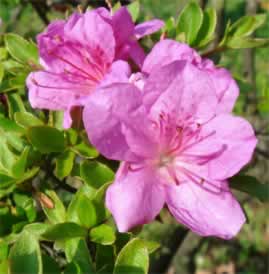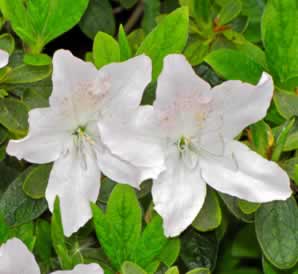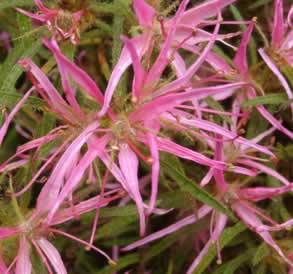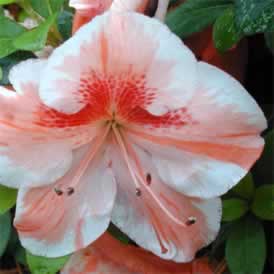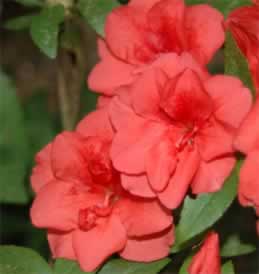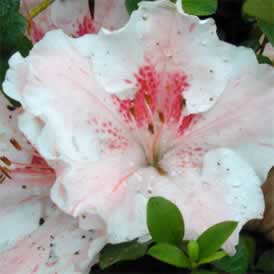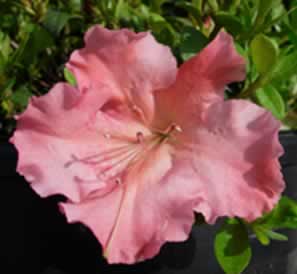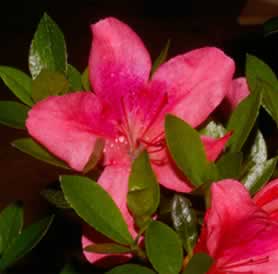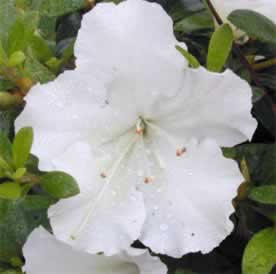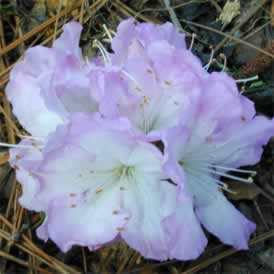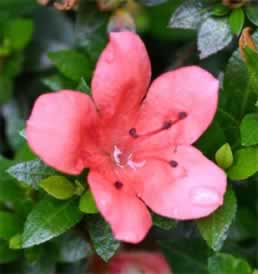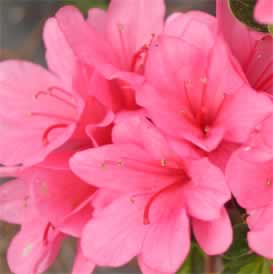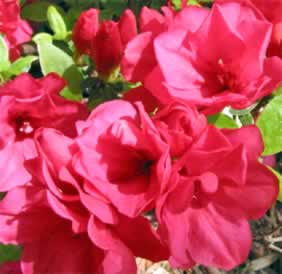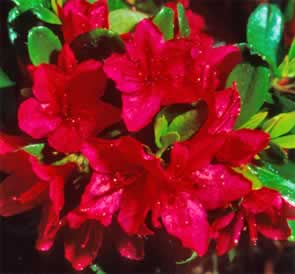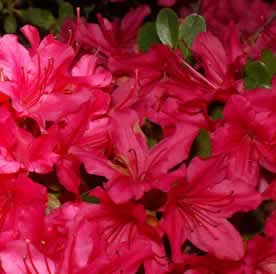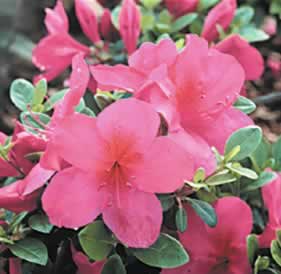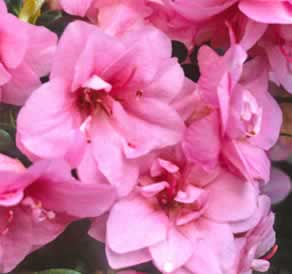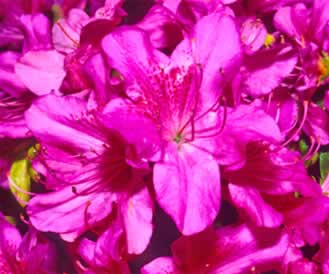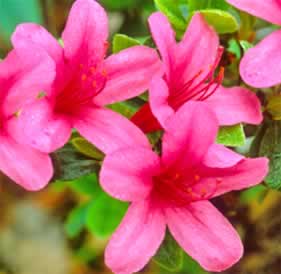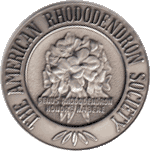R. aureum – 1', -15F. A dwarf shrub, it is an unusual dwarf “alpine” elepidote. A mature plant can reach as high as 2 feet in 10 years or be as prostrate as 4 inches. R. aureum is slow to flower and some forms are shy flowering. It is native over a wide area of N Asia including Siberia, N China and N Japan. R. degronianum ssp. heptamerum (R. metternichii or leather-leaf rhododendron) – 3', -15F. It grows 8 feet tall and has oval evergreen leathery leaves, 6 inches long, glossy on top, downy and rusty brown on the undersides. The flowers are rose pink. R. degronianum ssp. yakushimanum. (aka. yakusimanum) – 2', -15F. It was first described by Japanese botanist T. Naki in 1920. Fortunately a Japanese botanist and nurseryman Dr. Wada sent two plants to Lionel de Rothschild's garden at Exbury in the south of England in 1932. Many forms of R. yakushimanum have been identified and most are considered to be subspecies of R. degronianum. Some are identified as subspecies of R. makinoi and R. keskei. Yakushimanum has fuzzy indumentum on the undersides of its leaves and it is fairly hardy. It forms a compact well shaped plant. It is not only a popular plant, but it has by hybridized extensively for its compact habit, hardiness, and great foliage. R. indicum (indica azalea) – 1', 0F. It is one of the oldest Japanese azaleas, bred since ancient times, and it is the type most commonly used for ornamental pruning. It is a slow-growing evergreen shrub that eventually becomes 3 to 6 feet tall. Its 1 1/2-inch-long oval leaves grow on finely twigged branches. In the species, the flowers are red tinged with purple, about 2 to 3 inches wide, but it has been bred in many other colors. [Return to List] More Japanese Rhododendron Species
R. keiskei (Keisk rhododendron) – 2', -10F. It grows no higher than 2 1/2 feet tall and has yellow flowers 2 inches across. Its oval, pointed evergreen leaves, about 2 inches long, are olive green on top, rusty brown on the undersides; in autumn, they turn bronze red. R. kiusianum (Kyushu azalea) – 3', +5F. It is a semi-evergreen spreading azalea, growing 3 feet tall, but up to 5 feet wide. Its leaves are bright green, about 1 inch long. The plant is covered in late spring with a solid mass of purple 1-inch-wide flowers. R. mucronatum – 3', -5F. The snow azalea has Chinese ancestry but is not found in the wild. It is commonly used for ornamental pruning, grows 6 feet high and 4 to 6 feet wide. It is hardy to Zone 5, -15 F. Its many branches are densely covered with oval evergreen leaves, 1 1/2 to 2 1/2 inches long, matted with hairs. Its fragrant white flowers, 1 to 3 inches wide, often bloom in pairs and may be stained with green, lilac or pink at the base, depending on the variety. R. stenopetalum 'Linearifolium' (spider azalea) – 3', -15F. It is an unusual species. This species is normally 4-foot-tall shrub with narrow, ribbon-like evergreen leaves, 3 inches long and 1/2 inch wide, and rose-pink flowers with deeply divided petals. The variety 'linearifolium' (formerly R. macrosepalum 'Linearifolium' or R. linearifolium) is somewhat smaller, 3 feet tall, and the leaves are deciduous and 3 inches long. But the flowers are even more curiously shaped than those of the species; they have 1 1/4-inch-long sepals that overshadow the petals. The flowers of this variety are fragrant and have been bred in several colors; in one, 'Polypetalum', flower petals and leaves are so similar in size that the plant seems to have pink and green leaves. [Return to List] Examples of Japanese Evergreen AzaleasSatsuki evergreen azaleasKurume evergreen azaleasSatsuki Evergreen AzaleasThe Satsuki azaleas are late blooming azaleas from Japan with highly variable flower colors. In Japanese, Satsuki means fifth month of the Japanese lunar calendar (June). So plants bloom late (May, June and July), when most other azaleas are no longer blooming. Single, hose-in-hose and double flower forms are available. Flower size ranges from less than 1 inch to more than 5 inches across. Flower patterns include solids, stripes, multicolored sections, colored rings or margins, speckles and combinations of these. Many cultivars have variations of flower color and patterns on the same plant. They typically exhibit sporting a characteristic where the flowers are composed of two colors and no two flowers are exactly the same except those that are all one of the two colors. Most Satsukis have flowers that will be predominantly one color with blotches of the other color. Satsukis vary in hardiness but most are not very hardy. The hardiest are hardy to -10F and some are only hardy to +30F. Since they bloom fairly late, it is best to plant in partial shade. The Gumpo azaleas are popular Satsuki azaleas in the US. Popular cultivars include ´Pink Gumpo´, single, light-pink ruffled flowers; and ´White Gumpo´, single, white flowers with small flecks of purplish pink and a light-green blotch. [Return to Index] Satsuki Evergreen Azaleas
Aikoku— 2', 0°F. The 2½-3'' flowers vary from white with purple-pink stripes to totally purple-pink with white margins. Stays low and will spread to about 3' Beni Kirishima — 3', -5°F. Double, 2" flowers saturated in orange-red tones with darker blotches. Mounding in habit. Eikan — 3', -5°F. An azalea with variable blossoms; ‘Eikan' hosts a myriad of colors. In June, 3-4" flowers show shades of snowy white and/or delicate salmon pink in combinations including stripes, spots and blushes. A vigorous grower, ‘Eikan' reaches a height of about 2' and continues to spread. Such personality makes this a must for your garden. Gumpo Pink — 2', -5°F. Flowers 2-3" across show rose-pink tones with darker flecks. ‘Gumpo Pink' grows low and compact. [Return to List] More Satsuki Evergreen Azaleas
Gumpo Red — 2',-5°F. Rosy red flowers on a compact plant as with the other "Gumpos". Good for bonsai and pot culture. Gumpo White — 2', -5°F. Wavy 2-3" white flowers with occasional purple flecks and small, glossy leaves make this plant especially attractive. Similar in habit to ‘Gumpo Fancy,' plant grows low and compact. Haru-Same— 2', -5°F. White, large purple blotch, some striping end sectors of purple, variable, 2 - 4”, low spreading, to 2’, Late, medium green leaf. Kazan— 1', -5°F. Gardeners and bonsai artists alike seek this favorite for its splendid foliage and flowers. A slow grower, ‘Kazan' is spiked with heavy stems that carry heart shaped, waxen leaves. In May ‘Kazan' blooms showy 1-2" small lobed flowers in hues of salmon-pink with red-violet throats. A young bloomer, these flowers can appear on a plant as small as 1". Also known in the U.S. as ‘Rukizon', although its correct name is ‘Kazan'. [Return to List] Kurume Evergreen AzaleasKurume azaleas which originated in Japan are hardy to Zone 7, +5° F. After five to eight years in the garden, most Kurume azaleas become dense 18- to 30-inch bushes with small glossy leaves. In spring the evergreen foliage is hidden by 1-inch flowers. Typical varieties are 'Coral Bells', medium pink; 'Eureka', similar to 'Coral Bells' but hardier; 'Glory', salmon pink; 'Hershey's Red', rose red; 'Hino Crimson', crimson; 'Hinodegiri', bright red; 'Lorna', bright pink; 'Polar Bear', white; and ´Wakaebisu´, deep yellow-pink flowers with rounded petals, hose-in-hose form.. [Return to Index] Kurume Evergreen Azaleas
Coral Bells’ — 2', -5°F. Blooming in March with 1" hose-in-hose flowers are a warm rose-pink with darker veins. Low and spreading, ‘Coral Bells' mounds to 2½' high. A very special form. Hershey’s Red’ — 5', -10°F. A very bright, double red flower on a plant that is compact and hardy. Good foliage and bright flower make this an exceptional azalea. Hino Crimson’ — 2', -10°F. Bright crimson flowers unfold in April, holding their color well into ensuing weeks. This attribute, coupled with sun tolerance and red winter foliage, makes ‘Hino Crimson' an excellent all around choice. Planted in the open, it grows to a dense 2½' mound, although it adapts well for use as hedging. Very popular! Hinode-giri’ — 2', +5°F. One of the more sun-tolerant hybrids, this azalea produces multitudes of rose-crimson flowers early to mid-season. Small, glossy leaves turn bright red in winter on this dense and shapely plant. [Return to List] More Kurume Evergreen Azaleas
Mother’s Day’ — 6', -5°F. A hybrid of ‘Hinode-giri', ‘Mother's Day' was awarded a Horticultural Commendation by the R.H.S. With their clean lines, pure color, and texture heavier than most, these flowers have substance." Two inch, "hose-in-hose" to semi-double blooms are rose-red, with slightly darker spotting in the throat, which adds depth rather than contrast. Rosebud’ — 4', -5°F. True to its name, ‘Rosebud' displays blooms whose shell pink tones and double, hose-in-hose structure recall the classic beauty of roses. A slow grower, this tidy azalea is characterized by spreading growth. Sherwood Orchid’ — 5', -5°F. Syn. ‘Sherwoodi'. Mid-season flowers reveal a unique palette: from afar, they glow a deep magenta with rose undertones. Upon closer scrutiny, they fade in subtle streaks toward the corolla, presenting a red-orange flare dotted with blood-red flecks. Sylvester’ — 3', -5°F. Composed of 5 single, rounded elongated lobes, clear pink flowers with dark rose corollas. Foliage is medium green and habit is low and spreading. Inter plant with low growing rhododendron hybrids with complementary bloom colors for a finely textured evergreen garden. Such colors will distinguish ‘Sylvester's' elegantly simple blooms. [Return to List] How To Grow Japanese RhododendronsPlants bearing the code designation H-1 survive to -25°, H-2 to -15°, H-3 to -5°, H-4 to 5°, H-5 to 15°, H-6 to 25° and H-7 to 32°. Keiskei has an H-2 rating and is hardy in Zones 5-9. Metternichii is less cold resistant and has an H-3 rating and grows best in Zones 6-10. The remaining azaleas have an H-2 rating and do well in Zones 5-10. Rhododendrons grow best in partial shade, since full sunlight tends to bleach the flowers. They need an acid soil with a pH of 5.0 to 6.0, well mulched with organic material. Mix garden loam with equal parts of coarse sand and ground bark or oak leaves before planting. Soil around the rhododendrons' shallow roots must be kept cool and moist but well drained. All except leather-leaf rhododendrons transplant well in the spring, or in the fall if mild winter weather does not damage the shallow-rooted plants. Fertilize once a year after the plant blooms with a mixture of 5-10-5 and cottonseed meal. Prune rhododendrons after the flowers have faded to induce new growth. Most evergreen rhododendrons are propagated from cuttings rooted in sand or a mixture of sand and peat. Deciduous rhododendrons are propagated by seed, grafting or cutting. Directory of Contents for Henning's Rhododendron & Azalea Pages •• Providing Information about the Genus Rhododendron since 1996
••
Articles Published by the American Rhododendron Society
Compatibility & Webmaster information: These pages were created in Adobe GoLive, Adobe DreamWeaver, and BBEdit by Steve Henning rhodyman @ earthlink.net [In the news: 2012 ARS Silver Award, 2019 ARS Gold Award.]
Last Updated:
July 6, 2020
|

